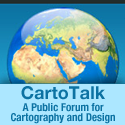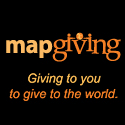Features
We developed Natural Earth as a convenient resource for making custom maps. Unlike other map data intended for scientific analysis or military mapping, Natural Earth is designed to meet the needs of production cartographers using a variety of software applications. Maximum flexibility is a goal.
Natural Earth Vector comes in ESRI shapefile format, the de facto standard for vector geodata. Character encoding is UTF-8.
Natural Earth Raster comes in TIFF format with a TFW world file.
All Natural Earth data use the Geographic coordinate system (projection), WGS84 datum
Intelligent data: The attributes assigned to Natural Earth vectors make for more efficient mapmaking. Most lines and areas contain embedded feature names, which are ranked by relative importance. Up to eight rankings per data theme allow easy custom map “mashups” to emphasize your map’s subject while de-emphasizing reference features. Other attributes focus on map design. For example, width attributes assigned to rivers allow you to create tapered drainages. Assigning different colors to contiguous country polygons is another task made easier thanks to data attribution.
Character encoding: Natural Earth uses UTF-8 character encoding to support internationalization with a full range of language scripts (and even emojis: ? ? ?). Initial versions of Natural Earth were in the Windows-1252 encoding limited to Latin-based scripts. Applications like QGIS and OpenOffice handle UTF-8 well. ArcGIS supports UTF-8 since version 10.2.1, and their technical article has details on configuring earlier versions to work with UTF-8. GDAL/OGR and Postgres/PostGIS also support UTF-8. Natural Earth shapefile character encoding is specified in the code page flag in the shapefile’s DBF file and for additional compatibility is also specified in the CPG file. Version 3 of Natural Earth switched to UTF-8 and version 4 fixed encoding conversion errors and omissions.
Projection: Natural Earth’s WGS84 projection is specified in shapefile’s PRJ file. It can also be described as a PROJ4 code EPSG:4326 string “+proj=longlat +ellps=WGS84 +datum=WGS84 +no_defs”.
Other key features:
- Vector features include name attributes and bounding box extent. Know that the Rocky Mountains are larger than the Ozarks.
- Large polygons are split for more efficient data handling–such as bathymetric layers.
- Projection friendly—vectors precisely match at 180 degrees longitude. Lines contain enough data points for smooth bending in conic projections, but not so many that computer processing speed suffers.
- Raster data includes grayscale-shaded relief and cross-blended hypsometric tints derived from the latest NASA SRTM Plus elevation data and tailored to register with Natural Earth Vector.
- Optimized for use in web mapping applications, such as Google or Yahoo, with built-in scale attributes to direct features to be shown at different zoom levels.
Click on boxed numbers below to jump to theme’s detail page and download data.
Cultural Vector Data Themes:

| 10 50 110 | Countries – matched boundary lines and polygons with names attributes for countries and sovereign states. Includes dependencies (French Polynesia), map units (U.S. Pacific Island Territories) and sub-national map subunits (Corsica versus mainland Metropolitan France). |
| 10 50 | Disputed areas and breakaway regions From Kashmir to the Elemi Triangle, Northern Cyprus to Western Sahara. |
| 10 50 | First order admin (provinces, departments, states, etc.) – internal boundaries and polygons for all but a few tiny island nations. Includes names attributes and some statistical groupings of the same for smaller countries. |
| 10 50 110 | Populated places – point symbols with name attributes. Includes capitals, major cities and towns, plus significant smaller towns in sparsely inhabited regions. We favor regional significance over population census in determining rankings. |
| 10 50 | Urban polygons – derived from 2002-2003 MODIS satellite data. |
| 10 | Parks and protected areas – US National Park Service units. |
| 10 50 110 | Pacific nation groupings – boxes for keeping these far-flung islands tidy. |
| 10 | Water boundary indicators – partial selection of key 200-mile nautical limits, plus some disputed, treaty, and median lines. |
Physical Vector Data Themes:

| 10 50 110 | Coastline – ocean coastline, including major islands. Coastline is matched to land and water polygons. |
| 10 50 110 | Land – Land polygons including major islands |
| 10 50 110 | Ocean – Ocean polygon split into contiguous pieces. |
| 10 | Minor Islands – additional small ocean islands ranked to two levels of relative importance. |
| 10 | Reefs – major coral reefs from WDB2. |
| 10 50 110 | Physical region features – polygon and point labels of major physical features. |
| 10 50 110 | Rivers and Lake Centerlines – ranked by relative importance. Includes name and line width attributes. Don’t want minor lakes? Turn on their centerlines to avoid unseemly data gaps. |
| 10 50 110 | Lakes – ranked by relative importance, coordinating with river ranking. Includes name attributes. |
| 10 50 110 | Glaciated areas – polygons derived from DCW, except for Antarctica derived from MOA. Includes name attributes for major polar glaciers. |
| 10 50 | Antarctic ice shelves – derived from 2003-2004 MOA. Reflects recent ice shelf collapses. |
| 10 | Bathymetry – nested polygons at 0, -200, -1,000, -2,000, -3,000, -4,000, -5,000, -6,000, -7,000, -8,000, -9,000,and -10,000 meters. Created from SRTM Plus. |
| 10 50 110 | Geographic lines – Polar circles, tropical circles, equator, and International Date Line. |
| 10 50 110 | Graticules – 1-, 5-, 10-, 15-, 20-, and 30-degree increments. Includes WGS84 bounding box. |
Raster Data Themes:

| 10 50 | Cross Blended Hypsometric Tints – Shaded relief combined with custom elevation colors based on climate—lowlands in humid areas are green and arid regions are brown. As in nature, the map colors gradually blend into one another across regions (x and y axis) and from lowlands to highlands (z axis), hence the name cross-blended hypsometric tints. |
| 10 50 | Natural Earth 1 – Satellite-derived land cover data and shaded relief presented with a light, natural palette suitable for making thematic and reference maps. Natural Earth I is available with ocean bottom data, or without |
| 10 50 | Natural Earth 2 – This data derived from Natural Earth 1 portrays the world environment in an idealized manner with little human influence. The softly blended colors of Natural Earth 2 are ideal for historical mapping, because it shows the world much as it looked before the modern era. |
| 10 50 | Ocean Bottom– Blended depth colors and relief shading of the ocean bottom derived from CleanTOPO2 data. The ocean color extends beneath land areas as a flat tint and requires shoreline masking with 10 million-scale Natural Earth vector data, or data of your own. |
| Bathymetry – Rasterized ocean depth polygons in a layered Photoshop file that you can manipulate for color and then save a GeoTIF to use with the provided TFW world file. It includes and ocean mask and land shaded relief reference layers. | |
| 10 50 | Shaded Relief – Grayscale shaded relief of land areas only derived from downsampled SRTM Plus elevation data clipped to Natural Earth vector coastlines. A flat gray tint occupies water areas. |
| 10 50 | Gray Earth – Worldwide terrain depicted monochromatically in shades of gray. It combines shaded relief and regionally adjusted hypsography that emphasizes both high mountains and the micro terrain found in lowlands. |
| 10 50 | Manual Shaded Relief – Generalized shaded relief of land areas fitted to Natural Earth coastline. A flat gray tint occupies water areas. |














